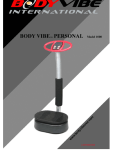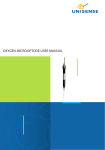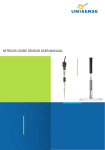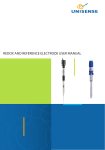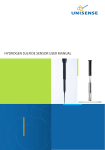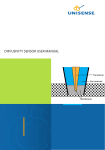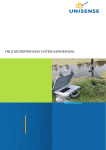Download APOX sensOr user mAnuAl
Transcript
APOX sensor user manuAl Cable includes guard AP Sensor and shield connections LEMO plug 3 APOX sensor user manual Copyright © 2010 · Unisense A/S Version October 2010 APOX sensor user manual Unisense A/S TABLE OF CONTENTS Congratulations with your new Product! . . . . . . . . . . . . . . . . . . . . . . . . . . . . . . 1 Support, ordering, and contact information 1 Overview . . . . . . . . . . . . . . . . . . . . . . . . . . . . . . . . . . . . . . . . . . . . . . . . . . . . . . . . . . . . . . . . . . . . 3 Getting started . . . . . . . . . . . . . . . . . . . . . . . . . . . . . . . . . . . . . . . . . . . . . . . . . . . . . . . . . . . . 4 Unpacking a new sensor Test the oxygen sensing part Test the action potential unit 4 4 4 Measurements . . . . . . . . . . . . . . . . . . . . . . . . . . . . . . . . . . . . . . . . . . . . . . . . . . . . . . . . . . . . . . 6 Mounting the sensor Electrical noise 6 6 Storage and maintenance . . . . . . . . . . . . . . . . . . . . . . . . . . . . . . . . . . . . . . . . . . . . . . . . 7 Cleaning the sensor 7 References . . . . . . . . . . . . . . . . . . . . . . . . . . . . . . . . . . . . . . . . . . . . . . . . . . . . . . . . . . . . . . . . . . 8 Warranty and liability . . . . . . . . . . . . . . . . . . . . . . . . . . . . . . . . . . . . . . . . . . . . . . . . . . . . 9 Repair or adjustment 9 Troubleshooting . . . . . . . . . . . . . . . . . . . . . . . . . . . . . . . . . . . . . . . . . . . . . . . . . . . . . . . . . 10 Congratulations with your new Product! Support, ordering, and contact information If you wish to order additional products or if you encounter any problems and need scientific/technical assistance, please do not hesitate to contact our sales and support team. We will respond to your inquiry within one working day. E-mail: [email protected] Unisense A/S Tueager 1 DK-8200 Aarhus N, Denmark Tel: +45 8944 9500 Fax: +45 8944 9549 Further documentation and support is available at our website www.unisense.com. Replacement of sensors Unisense will replace sensors that have been damaged during shipment provided that: • The sensors were tested immediately upon receipt in accordance with the delivery note and the manual • The seal is still intact. • The sensors are returned to Unisense for inspection within two weeks. • The sensors are correctly packed for return to Unisense, in accordance with the note included in the sensor box. 1 Recommended amplifiers One-channel amplifier: OXY-Meter or Microsensor Monometer Multi-channel amplifiers: Microsensor Multimeter or Microsensor Multimeter - 4-channel Oxymeter The action potential sensing part must be connected to an action potential meter Overview The Unisense APOX microsensor is a miniaturized Clark-type oxygen sensor combined with a platinum action potential microsensor. The sensor is designed for research within neurophysiology. The Unisense oxygen microsensor is a miniaturized Clark-type oxygen sensor with an internal reference and a guard cathode. The action potential electrode consists of a platinum tip protruding through a glass coating. With its minute tip size, excellent response time, and insignificant stirring sensitivity the APOX microsensor facilitates reliable and fast measurements with a high spatial resolution. AP Sensor and shield connections We recommend that the Unisense Oxygen microsensor and the Unisense Redox microelectrode manuals are consulted before proceeding. Warning Unisense sensors are neither intended nor approved for use on humans Cable includes guard The signal from the oxygen sensing part of the APOX sensor should be connected to a high-precision picoammeter. The action potential sensing part must be connected to an action potential meter and a reference electrode must be provided. In many set-ups, this reference consists of the metal support for the experimental subject. NOTICE For details on working principle consult oxygen sensor manual and redox electrode manual LEMO plug 2 3 8. The signal from the pre-amplifier should Getting started Unpacking a new sensor When receiving a new microsensor remove the shock-absorbing grey plastic net. Please do not remove the seal and protective tube before the following steps are successfully completed. Test the oxygen sensing part Connect, test, and calibrate the oxygen sensing part as described in the Unisense oxygen sensor manual. be sent to a 2nd-stage amplifier and then a device to view the signals. WARNING Do not remove seal and protective plastic tube before the following steps are successfully completed. 9. The total amplification should be around 2000x (this may vary). 10. The signal should be filtered with a low cut-off frequency of ~250 Hz and a high cut-off frequency of ~8kHz.. 11. Introduce high frequency voltage pulses into the saline bath using two separate electrodes connected to a function generator (e.g. use Physiologic Instruments Model# VCC600) Pulse duration should be Test the action potential unit 1. Place the tip of the sensor into a saline bath 2. Put a reference electrode (e.g. silver-silver chloride) into the saline bath and connect it to a large metal object (e.g. a metal stereo-tactic frame) 3. Connect the black AP wire on the APOX sensor to the input of a pre-amplifier 4. The reference for the pre-amplifier should be the same large metal object from 2) ~0.01 seconds or lower and it should repeat about 10 times /second. 12. Vary the amplitude of the voltage pulse until it is possible to distinguish the pulses from the background noise. You should be able to distinguish pulses below 100 mv. As an alternative way to test for basic function, connect the AP connection (black wire) and a separate reference electrode to a millivoltmeter. Then, connect the shield connection to the reference plug of the millivoltmeter and finally perform the function test described in the Unisense Redox electrode manual. 5. Leave the blue wire disconnected 6. Connect the external ground of the picoammeter (plug in the back) to the reference of the pre-amplifier (the large If the sensor functions according to the above procedure, the seal and protective plastic tube can be carefully removed and measurements can be started. metal object) 7. Shield the connections between the sensor and the pre-amplifier with tin foil or another Faraday cage-like device and connect this shield to the large metal object from 2) 4 5 Measurements Storage and maintenance Mounting the sensor Store the sensor in the protective plastic tube used for shipping. The microsensor can be stored with the tip exposed to water or air. The room in which the oxygen microsensor is stored should be dry and not too hot (10-30°C). If the sensor is used regularly it can be stored polarized. Lateral movements of the microsensor and physical disturbance of the microsensor equipment or table should be avoided as they may cause the tip to break. Therefore measurements should be performed only in a stabilized set-up. We recommend the Unisense lab stand LS18 and the Unisense micromanipulator MM-33 (MM33-2 double). The set-up should be placed on a sturdy table free of moving or vibrating devices. Electrical noise Cleaning the sensor The electrode can by cleaned by immersing it in nitric acid. Keep the electrode in the nitric acid solution for about 30 minutes and allow it to cool and rinse with water afterwards. The oxygen and action potential sensor signals may be affected by electrical noise in the environment and by physical disturbances. Thus precautions should be taken to minimize such effects. Electrical shielding in the form of a Faraday cage may be necessary. As described in the Unisense Oxygen microsensor and the Unisense Redox microelectrode manuals, the set-up must be physically stable. Connecting the sensor Connect the AP connection (black wire) to a suitable amplifier. The APOX sensor also has a shield connection, which can be connected to a ground connection, the AP amplifier reference plug, or the AP amplifier chassis to reduce electrical noise. However, electrical noise is a complex phenomenon, and it is not certain that using this connection will improve the measurements. ‘Local’ shielding of naked connections with e.g. aluminium foil can be advantageous. The user will have to experiment with the specific set-up to find the optimal use of shielding. When the sensor is fully connected, the measurements can be performed. 6 7 References Warranty and liability • Masamoto, K.; Vazquez, A.; ang, P.; im, S. Microsensors are consumable items. The sensors are tested thoroughly before packaging and shipment. G. Brain Tissue Oxygen Consumption And Supply Induced By Neural Activation. 2009. • Mayhew, W.; John, E. NEUROSCIENCE: A Measured Look at Neuronal Oxygen Consumption. Science 2003, 299, 1023-1024. • Thompson, J. K.; Peterson, M. R.; Freeman, R. D. Single-Neuron Activity and Tissue Oxygenation in the Cerebral Cortex. Science 2003, 299, 1070-1072. • Thompson, J. K.; Peterson, M. R.; Freeman, R. D. Separate Spatial Scales Determine Neural Activity-Dependent Changes in Tissue Oxygen Within Central Visual Pathways. J Neurosci 2005, 25, 9046-9058. • Viswanathan, A.; Freeman, R. D. Neurometabolic Coupling in Cerebral Cortex Reflects Synaptic More Than Spiking Activity. Nature Neuroscience 2007, 10, 1308-1312. Warranty for sensors: N2O sensors: 60 days from shipment. Standard Oxygen sensors: 180 days from shipment. All other sensors excluding special sensors: 90 days from shipment. If, within the above specified period, the sensor(s) fail to perform according to the specifications, Unisense will replace the sensor(s) free of charge. Unisense will only replace dysfunctional sensors if they have been tested according with the instructions in the manual upon receipt of the sensor(s).The warranty does not include repair or replacement necessitated by accident, neglect, misuse, unauthorized repair, or modification of the product. Physical damage to the tip of the sensor is not covered by the warranty. Liability In no event will Unisense be liable for any direct, indirect, consequential or incidental damages, including lost profits, or for any claim by any third party, arising out of the use, the results of use, or the inability to use this product. Repair or adjustment Sensors and electrodes cannot be repaired. Other equipment that is not covered by the warranty will, if possible, be repaired by Unisense with appropriate charges paid by the customer. In case of return of equipment please contact us for a return authorization. For further information please see the documents “Conditions for Sale and Delivery for Unisense” and “Warranty and Shipping Information”. 8 9 Troubleshooting Please see the troubleshooting sections of the Unisense Oxygen microsensor and the Unisense Redox microelectrode manuals. If you encounter other problems and need scientific/technical assistance, please contact [email protected] for online support (we will answer you within one workday) 10 Unisense, Denmark www.unisense.com · [email protected]










